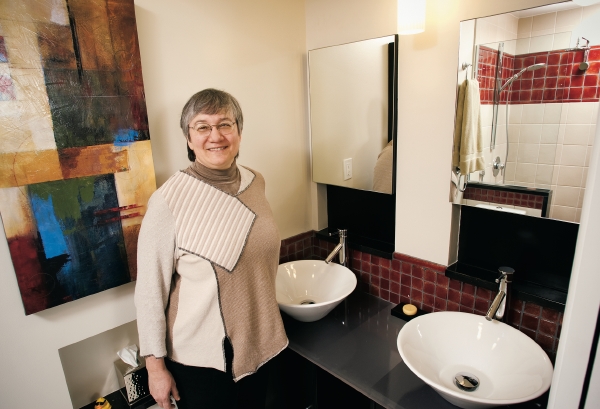Leaky pipes are never good news. But last spring, Emily Mintz turned what could have been an unpleasant home repair into a catalyst to go green.
Half a year—and a lot of research—later, her master bath featured recycled-glass tile, certified Energy Star products, a dual-flush toilet, recessed LED lights, and a solar-tube skylight.
“Little by little, we’ve been trying to live gentler on the Earth,” says Mintz, a real-estate agent who lives with her husband in North Bethesda. She’s part of a trend to make ecosmart choices in bath design.
“Most people can go green to a certain degree,” says Ilene Kanner of Tunis Kitchen & Bath Showroom in Bethesda. Kanner says many clients make ecofriendly decisions where they can. That’s good news when you consider that the US population nearly doubled from 1950 to 2000, while water usage tripled. Experts predict that 36 states could face water shortages by 2013. About 17 percent of household water use is in the shower alone.
“The most cost-efficient way to become environmentally friendly is through water savings—that’s where you can make the most impact quickly,” says Chandler Fox of Foxcraft Design Group in Falls Church.
Many solutions are simple and affordable, such as low-flow showerheads and faucet aerators. Check for the WaterSense label, the sign of a program sponsored by the Environmental Protection Agency that identifies toilets and faucets proven to be about 20 percent more water-efficient than other products on the market. You’ll find a list of certified products at epa.gov/watersense.
When looking at products, you might want to make sure materials are as ecofriendly as they claim to be, says architect Hal Bolton of Terraplane Studios in DC.
“Check a third-party certifier to make sure what you’re getting is living up to what they say,” says Bolton. He suggests checking GreenGuard (greenguard.org), which verifies that a product emits lower levels of chemicals and other pollutants, or Cradle to Cradle (c2ccertified.com), which evaluates a product’s use of ecofriendly materials and renewable energy and its ability to be reused. Energy Star products (energystar.gov) have met strict efficiency guidelines set by the federal government. You may also want to be aware of where materials originated: As at a farmers market, the more local the manufacturer, the lower a product’s carbon footprint.
Toilets: Flush With Options
Going green: According to the Natural Resources Defense Council, homeowners flush a quarter of their water bill down the toilet. If your toilet predates 1992, the best tactic is replacing it—no fancy models necessary. Old models use 3.5 gallons of water or more per flush. Since 1992, the federal Energy Policy Act has required new toilets sold in the United States to use a maximum of 1.6 gallons a flush. No matter your toilet’s age, check for leaky valves, one of the worst water wasters—up to 200 gallons a day. For a quick prognosis, squirt a drop of food coloring into the tank. If color shows in the bowl without flushing, there’s a leak.
Greener: More efficient are dual-flush toilets, in which pushing one button releases almost a gallon of water, while the other releases 1.6 gallons. Toto makes popular models such as the Eco Drake ($380) and the Aquia ($437). “Toto is the no-question leader” in quality and quantity, though Kohler is gaining, says architect Anthony Wilder of Cabin John.
Greenest: The most dedicated tree huggers might consider waterless urinals and composting toilets—though technology lags on the toilets and regulations remain varied on what’s allowed. “Composting toilets are common in Europe, but this side of the world, people are not at all open to them,” Wilder says. Still, waterless urinals garner impressive results: In workplaces, Kohler’s sleek Steward model ($765) can save 40,000 gallons of water annually.
Showers: Go With the Flow
Going green: We’ll admit, few things beat a steamy shower cascading from a rainwater showerhead. But bigger showerheads need bigger pipes. “You’re wasting a lot more water, and it costs more,” Wilder says. A first step to going green is to update a showerhead that’s more than ten years old, because newer heads use less water—2.5 gallons or less per minute versus the previous norm of 5—without sacrificing comfort. “There’s a lot of consumer concern over dribbly showerheads, but that’s not true,” Fox says. “New showerheads have a lot of force.”
Greener: Replacing a showerhead with a low-flow model and installing aerators on sink faucets gives big bang for your buck. Jason Holstine, owner of Amicus Green Building Center in Kensington, recommends a low-flow showerhead called Croma E 75 Green by Hansgrohe, which provides “a very good stream” at 1.6 gallons a minute (starting at $27; options vary). “An air shower can cut 30 percent of water use,” Wilder says. “It infuses the water with air and makes it feel like there’s more water coming down on you.” But buyer beware: Some users complain that aerators don’t hold water heat as well.
Greenest: A lot of energy goes to heat water. One way to cut costs is to install a recirculating pump such as the Taco Model007, which keeps water flowing slowly through the house so hot water is ready when you need it. You won’t have to run the shower for a minute or so before jumping in, which leads to significant water savings. However, mechanical kinks remain a problem. Silver Spring interior designer Ellen Gilday Witts recently installed a recirculating pump for one couple. “I don’t think they’re thrilled with it,” she says. “You turn on your cold water to brush your teeth, and you get intermittent spurts of hot water.”
Tankless water heaters, which provide hot water only as needed and eliminate the use of energy to fill a storage tank with hot water, are “the wave of the future,” says Wilder. For now, though, prices remain about triple those of standard water heaters (Rinnai’s version costs $600 to $1,300)—and Consumer Reports concluded that it can take up to 22 years to break even, longer than their standard 20-year lifespan. Fox says a tankless water heater is a good choice for weekend homes, pool houses, or garage apartments that aren’t used frequently. Bolton says solar hot-water heating is the next big thing and should become mainstream within a decade.
Lighting the Way
Going green: You can control brightness on existing light fixtures by installing dimmer switches, available at hardware stores. Incandescent and light-emitting-diode (LED) bulbs are dimmable, as are compact fluorescent lights labeled as such. Although fluorescent bulbs earned a bad rap in the past, today’s versions offer a warmer light, says Micaela Mendoza of Dee David & Co., a bathroom-design company in Falls Church: “Times have changed; they’re not what they used to be.” Translation: When applying makeup, you won’t run the risk of evoking a TV test pattern.
Greener: You could replace incandescent with more efficient bulbs. Choices include—in ascending order of price—halogen, compact fluorescent, and LED. Compact fluorescent and LED lights use 75 percent less energy than incandescent and last much longer—about 9 years for compact fluorescents, 20-plus for LEDs. Particularly nice for bathrooms, recessed LED lights glow warmly like incandescent bulbs while consuming just 11 watts or less. North Bethesda homeowner Emily Mintz installed two in her bathroom at $120 apiece. “LED gives a beautiful, almost natural light,” she says. For spots that need bright, white light at a lower cost, Mendoza suggests halogen reflector lamps placed on a dimmer.
Greenest: “Don’t overlook the importance of natural light,” Fox says. Besides installing windows, an efficient way to filter in outside light is via solar tube. A round reflective tube acts as a mini-skylight and provides a lot of light without using energy, he says. This past fall, Mintz installed a 21-inch sun tube, which looks like a round ceiling light but reflects and channels natural light shining in through a dome in the roof. “It glows all day long, and it’s in a north-facing room. We have no idea how bright it’s going to be in the summer,” she says.
More Ecofriendly Ideas
Paint: Consider nontoxic paint with low volatile-organic-compound emissions, such as the lines by Benjamin Moore, says Ellen Gilday Witts. Low-VOC paint can be harder to work with than regular paint, though its newfound popularity is helping to expand the offerings.
Vanities: For Witts, the ultimate ecofriendly choice is to repurpose an old dresser or sideboard as a vanity. “Reusing things is totally green,” she says. Or look for a composite-veneer cabinet constructed from recycled byproducts—a look that’s more contemporary than traditional.
Countertops: A concrete countertop can be very green if manufactured in a sustainable manner, but concrete can develop hairline cracks, says Witts. Bamboo countertops are a sustainable choice but are less durable than other options—and bamboo generally has to be shipped from overseas. Popular quartz products will last forever—good news for you; bad news for the landfill. Recycled plastic is finding new life as resin countertops by 3-Form and other manufacturers; you can cut costs by ordering from the company’s “Reclaim” page online (3-form.com). For beautiful but costly countertops, companies including Vetrazzo and IceStone offer artful surfaces cobbled together from recycled glass pieces and concrete.
Ventilation: “Always try to get windows in bathrooms,” Fox says. “You can’t underestimate the ability of a window to take care of ventilation problems.” Regulations require ceiling exhaust fans in bathrooms; Fantech and Panasonic make quiet and energy-efficient models. “It’s not sexy at all, but having a good vent fan is really key to reduce mildew,” says Amicus Green Building Center’s Jason Holstine. Consider installing a timer to avoid accidentally leaving a quiet fan on all day.
Tile: Recycled-glass tile is often as beautiful as it is high-end. Porcelain and ceramic tiles are sustainable products that cost less than glass. At Architectural Ceramics, owner Betty Sullivan has created “green aisles” to make it easier to identify ecofriendly products, including 14 lines of tile whose manufacturers use sustainable practices and materials, such as Mixed-Up Mosaics and Interstyle, both produced within 500 miles of Washington.
Heated flooring: A heated floor is a plush perk that can also be energy efficient—you don’t have to turn up the heat for the whole house just to stay warm when you get out of the shower. “Put a floor heater on a timer or thermostat,” Fox says. “You can have it come on at 6 am so it’s nice and toasty when you get up, and you can turn the heat down in that part of the house.” Stone and porcelain hold heat particularly well.
Green Resources
Amicus Green Building Center in Kensington stocks ecofriendly home goods, from paints and stains to lighting, appliances, and cabinets. 4080-A Howard Ave., Kensington; 301-571-8590; amicusgreen.com.
Eco-Green Living, which recently moved from Logan Circle to Takoma Park, sells green building materials such as bamboo flooring, nontoxic paint, and tankless water heaters. 6201 Blair Rd.; 202-234-7110; eco-greenliving.com.
Donate new and used building materials for tax deductions, or find materials priced 40 to 80 percent below retail at Community Forklift, 4671 Tanglewood Dr., Hyattsville; 301-985-5180; communityforklift.com.
Urban Solar Solutions, which shares a building with Community Forklift, sells a number of ecominded home products, including energy-efficient lighting. 4641 Tanglewood Dr., Hyattsville; 301-209-0011; urbansolarsolutions.com.
Habitat for Humanity’s ReStore sells used and surplus building materials at slashed prices. 7770-A Richmond Hwy., Alexandria; 703-360-6700; habitatnova.org.
Miko Wheeler Fine Countertops offers green cabinetry and countertop options—from glass to recycled plastic—plus paint and flooring. 1811 McGuckian St., Annapolis; 410-626-0027.
→ What’s In: Contemporary Bathrooms


















